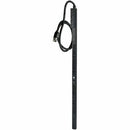Description
APC by Schneider Electric 30-Outlets PDU
Engineered for demanding data centers, server rooms, and network closets, the APC by Schneider Electric 30-Outlets PDU delivers reliable, monitored power distribution for critical IT equipment. This metered rack PDU provides real-time visibility into power usage, enabling proactive capacity planning and downtime prevention. With flexible mounting options, a robust 30-outlet configuration, and advanced remote management capabilities, it is a essential component of modern infrastructure designed to optimize energy efficiency and safeguard uptime.
- Real-time remote monitoring of connected loads with an intuitive web interface and mobile-friendly dashboards. IT teams can view live voltage, current, and power readings, track historical trends, export reports, and quickly identify anomalies. The PDU integrates with APC PowerChute and DCIM tools for centralized control and seamless data exchange, helping administrators stay on top of power consumption across racks and rows.
- Metered PDU design provides precise measurements of electrical usage to optimize energy use and prevent overloads. It captures total load and, on model variants, may offer per-outlet metering for granular insight into which devices drive peak demand. Readings can be scheduled or sampled at configurable intervals, enabling detailed reporting and smarter capacity planning across the data center.
- User-defined alarms warn of potential circuit overloads before critical IT failures occur. Set threshold values for voltage, current, and power, and deliver alerts via email, SNMP traps, or DCIM integrations. This proactive notification reduces mean time to repair and helps maintain service levels during spikes in demand or equipment changes.
- Flexible installation options and robust build quality. The 30-outlet PDU is designed for standard 19-inch racks with options for vertical or horizontal mounting to suit diverse rack layouts. Durable construction, surge protection, and reliable thermal performance support continuous operation in hot and densely populated data center environments, while ergonomic outlet spacing simplifies cabling management.
- Enhanced reliability and manageability for data centers, server rooms, and edge deployments. Compatible with DCIM platforms and secure remote access, it supports role-based permissions, firmware updates, and centralized monitoring to deliver a holistic view of power usage and infrastructure health, enabling optimal workload placement and energy efficiency initiatives.
Technical Details of APC by Schneider Electric 30-Outlets PDU
- Metering and monitoring: Real-time measurements of voltage, current, power (kW), and energy (kWh); select SKUs offer per-outlet metering for granular load analysis; accessible via web UI and compatible DCIM tools for centralized visibility.
- Management and alerts: Web-based management with SNMP support; user-defined alarm thresholds; alert delivery through email, SNMP traps, and integration with DCIM platforms to keep teams informed and ready to respond.
- Physical configuration: 30 outlets arranged for efficient distribution; 19-inch rack-mount compatibility with standard rails; options for vertical or horizontal installation to fit various rack designs and cable routing schemes.
- Power input and efficiency: Designed for common data-center power inputs with safe, reliable operation; optimized for energy efficiency and stable performance in critical IT environments.
- Connectivity and security: Network-enabled for remote monitoring; supports secure authentication, audit logs, and firmware updates to maintain security and reliability across the monitoring lifecycle.
How to Install APC by Schneider Electric 30-Outlets PDU
Follow these steps to install the APC 30-Outlets PDU securely and begin monitoring power distribution from day one:
- 1. Plan your rack layout to optimize cable management, airflow, and accessibility to outlets for critical equipment.
- 2. Mount the PDU in the rack using the supplied 19-inch rack-mount hardware, ensuring it is level and securely fastened to withstand service introductions and rack movement.
- 3. Connect the PDU to your power source, matching the input rating and ensuring the circuit can handle anticipated load. Verify that the power source is stable and within tolerance.
- 4. Establish network connectivity if your model supports management over the network. Connect the Ethernet port to your network, configure IP addressing, and verify reachability from your DCIM or management system.
- 5. Configure monitoring and alarms via the web UI or management software. Set alarm thresholds for voltage, current, and total power, and enable notification channels (email, SNMP traps, or DCIM integration).
- 6. Route and organize power cables to IT equipment from the PDU outlets. Maintain clean cabling to facilitate cooling airflow and simplify future maintenance or reconfiguration.
- 7. Power on devices and validate readings. Confirm that the PDU dashboard displays accurate measurements and that alert channels are functioning as intended for proactive monitoring.
Frequently asked questions
- What is a metered PDU? A metered PDU provides real-time measurements of electrical usage for the entire unit and, depending on the model, may offer per-outlet metering. This visibility supports capacity planning, energy management, and faster fault detection in data centers and IT closets.
- How does a 30-outlet PDU benefit data centers? The 30-outlet configuration enables efficient power distribution to a large number of servers, storage devices, switches, and other devices in a compact 19-inch rack footprint. Coupled with remote monitoring and alarms, it helps maintain uptime, optimize energy use, and support scalable growth.
- Can alarms be customized? Yes. Users can set threshold values for voltage, current, and total power. Alerts can be delivered via email, SNMP traps, or DCIM integrations, ensuring IT teams are informed in real time of potential issues.
- Is installation difficult? Not with the right plan. The PDU is designed for straightforward rack mounting, simple electrical connections, and network-based monitoring, minimizing downtime during deployment.
- What monitoring features are included? Expect real-time metering, readings for voltage and current, energy usage (kWh), and logs suitable for auditing and capacity planning. Some models provide more granular per-outlet data for pinpoint diagnostics.
- Which environments is this PDU best suited for? Data centers, server rooms, network closets, and edge deployments where reliable power distribution and visibility into energy use are critical to maintaining performance and uptime.
Customer reviews
Showing - Of Reviews


